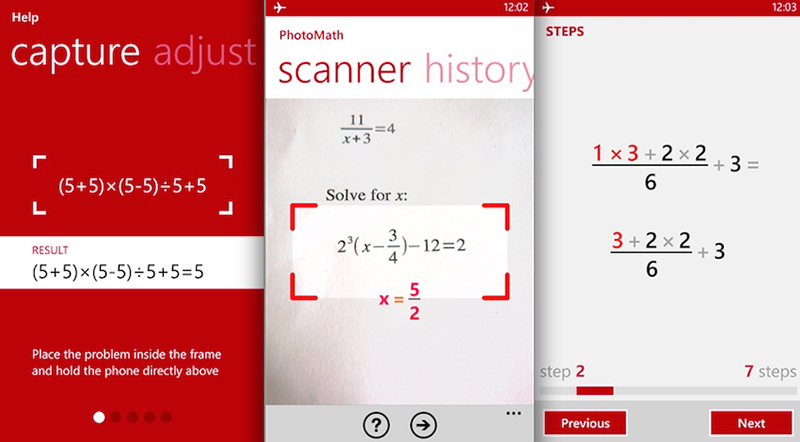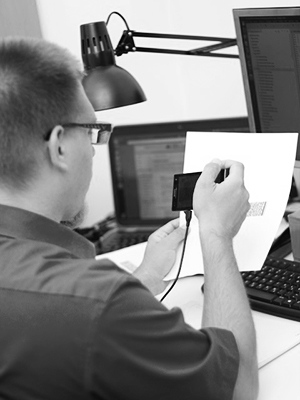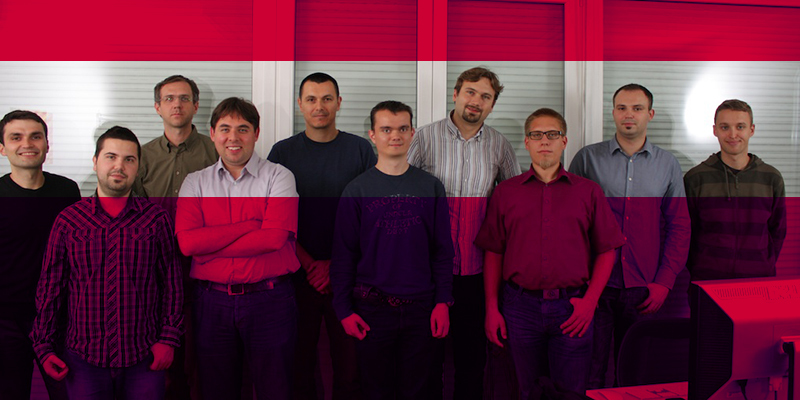Developer Stories: Microblink PhotoMath
About this application has written many world publications. And not just technical ones like Engadget , Techcrunch and CNET . A small app came to the attention of such giants as Time magazine , Forbes and Business Insider and the Ellen DeGeneres show.

So why is the PhotoMath application so interesting? Perhaps because the Croatian MicroBlink development team embodied our childhood dream by handing a magic wand to solve even complex mathematical equations (in fact, not at all harmful, but, on the contrary, useful for teaching mathematical sciences, but more on that later). Our colleagues managed to contact the developers and talk about how this small, but successful application was created, and what we would expect from them in the future. In the meantime, your child burns the last volume of “Finished Homework,” let me invite you to read the excerpts from this interview.
Free PhotoMath application was conceived as a useful and visual tool for solving mathematical equations, which is based on data recognition technology (OCR-technology) coming from the camera of a mobile device.
')
All you need to do to calculate the equation is to point the camera of the smartphone on the task, select the boundaries of the equation (you can adjust it manually), take a picture of the example and wait until the solution appears on the screen. App can scan tasks from both paper and screen, but in the second case it may take more time to process.
Let's make a reservation right away that the handwriting text is not recognized yet and many users are indignant in the app store reviews in anticipation of adding this feature from the developers.

The educational part of the application is that the application gives not only the correct answer, but also allows you to view all the stages of solving a mathematical equation. All examples solved using the application can be returned at any time, since they are automatically stored in a special section.

You can try the PhotoMath for Lumia smartphones in the above example by first downloading it from the Windows Phone Store . Also, the application exists in the version for iOS , and soon should appear on the Android platform.
What inspired you to develop PhotoMath?
We developed mobile OCR technology and applications for several clients from the banking sector, designed to transfer payments and pay bills. The text recognition technology implemented in these programs allowed users, using a smartphone’s camera, to transfer data to the device in a matter of seconds and pay. At some point we wanted to expand the application of our development to other areas, but we did not have a real demonstration application.
One of our colleagues came up with the idea that [since he often has to check homework for his son] he needs an application to quickly solve mathematical problems, and that it would be nice to create such an application. We did not have time for this idea to disperse throughout our team, as we have already applied for a local event held within the framework of AppCampus . Surprisingly, literally at the first attempt, we won their hearts and in a few months received a grant to develop the application.

With the growing popularity of your application, conversations began to appear more and more often that PhotoMath would allow to “deceive the system” or even completely shut off the head to schoolchildren and students, doing all the work for them. What do you think about that?
We rightly believe that the one who wants to write off will always find a way to write off using any device or cheat sheet. With the help of the PhotoMath application, we want to help children and their parents learn mathematics in a new way - with the help of an application that details the solution of a concrete example.
You must admit that it often happens that the students have no one to ask for help in solving problems in mathematics, or the knowledge of parents in mathematics is not enough. In such cases, our PhotoMath app should come to the rescue.
What was the development process like?
The development process was conditional in two stages. At first, we developed universal OCR technology. And it took us 2-3 years. And then it took about half a year to develop the mathematical engine and the application itself.

Three young developers from our team worked directly on the application, and we, three “old-timers”, only followed the creation of the product and controlled the development process.
What application would you develop if you had unlimited resources and a budget?
Since all of our company's attention is focused on the technology of image processing on portable devices, we have a lot of ideas in this area. The first application that we would like to implement was a mobile app that could recognize food, or more precisely, various dishes. Such an application could offer users various options, ranging from the preparation of content for publication in social networks and ending with the display of actual statistics on calories and content in a dish of certain substances.

Here is another example of the flight of our fantasy: a robot that moves autonomously through your home or office and remembers all the things around you. What is it for? Yes, so that users could ask the robot or mobile application connected to this robot: “Where am I doing my glasses?”
And such an application could save human lives: today people often walk down the street, staring at their mobile phones. Passing through the road, they have a great chance not only to become the cause of the accident, but also to suffer in it. Imagine that there would be such an application (a kind of mobile guardian angel) that would use your mobile camera and microphone to inspect the space around you and notify you of any obstacles on your way. For example, if you have a step in front of you or you come to a crossroads.
What awaits PhotoMath and your other applications in the near future?
Today we are fully focused on improving PhotoMath and our OCR technology. As for the mathematical application, in the near future we will work on the automatic calculation of more complex calculations and the improvement of the recognition system (maybe we can also use handwriting input sometime). If we talk about the next steps of our company, now we are working on the release of the SDK "machine vision", so that other developers can create their own applications using our recognition technology.

Download the PhotoMath app on your Lumia at this link .

And we also write in: Geektimes | Twitter | VKontakte | Facebook | Google+

So why is the PhotoMath application so interesting? Perhaps because the Croatian MicroBlink development team embodied our childhood dream by handing a magic wand to solve even complex mathematical equations (in fact, not at all harmful, but, on the contrary, useful for teaching mathematical sciences, but more on that later). Our colleagues managed to contact the developers and talk about how this small, but successful application was created, and what we would expect from them in the future. In the meantime, your child burns the last volume of “Finished Homework,” let me invite you to read the excerpts from this interview.
But first, let's talk a little more about the application:
Free PhotoMath application was conceived as a useful and visual tool for solving mathematical equations, which is based on data recognition technology (OCR-technology) coming from the camera of a mobile device.
')
All you need to do to calculate the equation is to point the camera of the smartphone on the task, select the boundaries of the equation (you can adjust it manually), take a picture of the example and wait until the solution appears on the screen. App can scan tasks from both paper and screen, but in the second case it may take more time to process.
Let's make a reservation right away that the handwriting text is not recognized yet and many users are indignant in the app store reviews in anticipation of adding this feature from the developers.

The educational part of the application is that the application gives not only the correct answer, but also allows you to view all the stages of solving a mathematical equation. All examples solved using the application can be returned at any time, since they are automatically stored in a special section.

You can try the PhotoMath for Lumia smartphones in the above example by first downloading it from the Windows Phone Store . Also, the application exists in the version for iOS , and soon should appear on the Android platform.
What inspired you to develop PhotoMath?
We developed mobile OCR technology and applications for several clients from the banking sector, designed to transfer payments and pay bills. The text recognition technology implemented in these programs allowed users, using a smartphone’s camera, to transfer data to the device in a matter of seconds and pay. At some point we wanted to expand the application of our development to other areas, but we did not have a real demonstration application.
One of our colleagues came up with the idea that [since he often has to check homework for his son] he needs an application to quickly solve mathematical problems, and that it would be nice to create such an application. We did not have time for this idea to disperse throughout our team, as we have already applied for a local event held within the framework of AppCampus . Surprisingly, literally at the first attempt, we won their hearts and in a few months received a grant to develop the application.

With the growing popularity of your application, conversations began to appear more and more often that PhotoMath would allow to “deceive the system” or even completely shut off the head to schoolchildren and students, doing all the work for them. What do you think about that?
We rightly believe that the one who wants to write off will always find a way to write off using any device or cheat sheet. With the help of the PhotoMath application, we want to help children and their parents learn mathematics in a new way - with the help of an application that details the solution of a concrete example.
You must admit that it often happens that the students have no one to ask for help in solving problems in mathematics, or the knowledge of parents in mathematics is not enough. In such cases, our PhotoMath app should come to the rescue.
What was the development process like?
The development process was conditional in two stages. At first, we developed universal OCR technology. And it took us 2-3 years. And then it took about half a year to develop the mathematical engine and the application itself.

Three young developers from our team worked directly on the application, and we, three “old-timers”, only followed the creation of the product and controlled the development process.
What application would you develop if you had unlimited resources and a budget?
Since all of our company's attention is focused on the technology of image processing on portable devices, we have a lot of ideas in this area. The first application that we would like to implement was a mobile app that could recognize food, or more precisely, various dishes. Such an application could offer users various options, ranging from the preparation of content for publication in social networks and ending with the display of actual statistics on calories and content in a dish of certain substances.

Here is another example of the flight of our fantasy: a robot that moves autonomously through your home or office and remembers all the things around you. What is it for? Yes, so that users could ask the robot or mobile application connected to this robot: “Where am I doing my glasses?”
And such an application could save human lives: today people often walk down the street, staring at their mobile phones. Passing through the road, they have a great chance not only to become the cause of the accident, but also to suffer in it. Imagine that there would be such an application (a kind of mobile guardian angel) that would use your mobile camera and microphone to inspect the space around you and notify you of any obstacles on your way. For example, if you have a step in front of you or you come to a crossroads.
What awaits PhotoMath and your other applications in the near future?
Today we are fully focused on improving PhotoMath and our OCR technology. As for the mathematical application, in the near future we will work on the automatic calculation of more complex calculations and the improvement of the recognition system (maybe we can also use handwriting input sometime). If we talk about the next steps of our company, now we are working on the release of the SDK "machine vision", so that other developers can create their own applications using our recognition technology.

Download the PhotoMath app on your Lumia at this link .
And we also write in: Geektimes | Twitter | VKontakte | Facebook | Google+
Source: https://habr.com/ru/post/248789/
All Articles